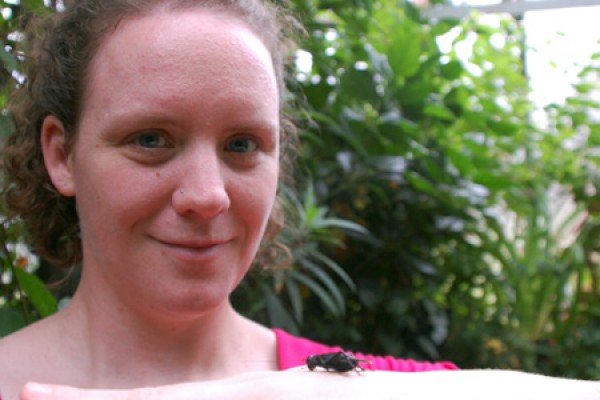 Lauren Fitzsimmons holds up a cricket. The post-doctoral fellow discovered that crickets celebrate winning fights with "victory dances," especially if other crickets are watching.
Lauren Fitzsimmons holds up a cricket. The post-doctoral fellow discovered that crickets celebrate winning fights with "victory dances," especially if other crickets are watching.
The next time you hear a cricket chirping in your yard, you might recognize the sound as a male bragging about the latest fight he won.
“A short burst of a lot of singing, sporadic, but closely tied together,” is how Lauren Fitzsimmons, an NSERC post-doctoral fellow in the lab of biology professor Dan Mennill, described the quality of the noise male crickets make after they win a fight – especially if they know other crickets are watching.
Fitzsimmons recently published an article in the journal Biology Letters which describes a series of experiments she conducted which involved placing male crickets in a small arena-like enclosure – which always leads to fights. The arena included a glass-separated viewing area, and she set up three audience situations: a male watching and listening to a fight, a female watching and listening to a fight, or no audience.
The results showed that all the males fought more violently, and put on more elaborate victory dances when a male or a female was watching than when they had no audience at all. Fitzsimmons, who conducted the experiment while working on her PhD at Carelton, compared the behaviour to a football player dancing in the end zone after scoring a touchdown.
Similar studies have been conducted relating behaviour to the social environment with birds, but not so much with insects, Fitzsimmons said.
“I wanted to take some of my experience from the bird world and apply it to the insect world,” said Fitzsimmons, who completed a master’s degree under Dr. Mennill’s direction in 2007 when she studied the vocal behaviour in black-capped chickadees, focusing on male-male song contests from a communication-network perspective - work which won her a Governor General's gold medal.
The work was interesting enough to catch the attention of National Geographic, which published an article about it in its on-line Daily News yesterday.
“I was really excited that they wanted to pick it up,” Fitzsimmons said during a phone interview from her Ottawa home.
Fitzsimmons, who returned to Mennill’s lab for a post-doc in May after completing her PhD in Ottawa last year, credited her supervisor for his energy and passion as source of inspiration, adding that he was instrumental in helping to guide and design many of her experiments.
“I had a really positive experience in his lab while I was working on my masters and he really hooked me on academic science,” she said.

.jpg)